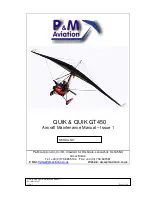
dIsposal
When choosing materials, skywalk places high value on environmental compatibility and the high-
est quality control. Should your glider some day no longer be flyable, remove all metal parts such
as shackles, pulleys, etc.
All remaining parts such as lines, material and risers can be turned in at a recycling center. The
metallic parts can be turned in at a metals recycling center. The best solution is to send your re-
tired skywalk glider directly to us. We will then take care of recycling it.
lIne repaIrs:
The main lines of the skywalk JOIN’T3 consist of a Dyneema- or Technora core and a polyester
sheath. Avoid heavy loads on individual lines as excessive stretching may be irreversible. Repeating
kinking of lines at the same spot reduces their strength.
Visible damage to lines, even if it’s only to the sheath, should be checked and possibly repaired.
New lines can be ordered from the manufacturer or from an authorized skywalk service center.
They will help you to replace defective lines. Before a line is replaced, the correct length has to be
verified by comparing it with the corresponding line on the other side of the wing. After the re-
placement and before your next flight, perform a line check by kiting up the glider on the ground.
HInts For MaterIal care
> Avoid leaving your glider unused in the sun or lying outside in bad weather.
> Avoid exposing your glider to abrasion by dragging it over sticks and stones.
> Always fold your glider carefully and loosely and avoid sharp creases and extreme compression
of the material.
> Always store the risers in the riser bag provided.
> Should the material come in contact with salt water, rinse it immediately and carefully with
fresh water and make sure that it has enough time to dry in a shady location.
> If you land in a tree, never pull hard on the lines or material to free your glider. Rather, do so
carefully and with patience. Once you have removed all leaves and branches from your glider,
inspect the line lengths and symmetry before your next flight.
> When laying out your glider, make sure that neither material nor lines are dirty as dirt particles
caught in the fibers can shorten the lines and damage the material.
> If lines get caught on the ground, they can get stretched or torn during launching. For this rea-
son, make sure that all lines are free and avoid stepping on them.
> Make sure that no snow, sand or stones find their way into the canopy because weight on the
trailing edge of the glider can brake or even stall it. Should this happen anyway, lift up the gli-
der by D-lines so that the air inlets are pointing down and the canopy can empty itself.
51
Summary of Contents for JOIN'T3 LTF 09:B
Page 1: ...Seriennr Handbuch 07 2013...
Page 28: ...28 TRAGEGURTE gemessen bis Innenkante Leinenschloss...
Page 30: ...30...
Page 31: ...31...
Page 32: ......
Page 33: ...33 Manual 07 2013 Serial No...
Page 56: ...56 Riser measured from the interior edge of the shackle...
Page 58: ...58...
Page 59: ...59...
Page 60: ...60...
Page 61: ...61 MANUEL DE VOL NUM RO DE S RIE...
Page 83: ...83 PLAN DE SUSPENTAGE...
Page 84: ...84 ELEVATEUR...
Page 88: ...88 Notes...
Page 89: ...89...
Page 90: ...90 Notes...
















































